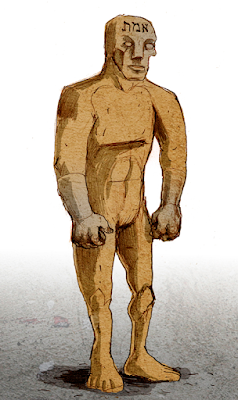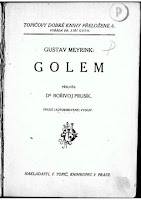
|
| Golem by Philippe Semeria (CC BY 3.0) |
In this (certainly overdue) second installment of the series devoted to artificial beings appearing in folklore and fantasy and science fiction narrative, as well as roleplaying games, today I will talk about the golem.
To read the first installment of the series, devoted to homunculi, you may follow this link.
Golem origins
Generally the golem is a humanoid creature composed of inanimate matter (clay or mud, but it can also be stone), typical of Jew mythology (something that it's also very common in other religious and mythological traditions).
This word first appears in Judeo-Christian religious texts like the Babylonian Talmud (Sanhedrin Tractate, page 38b), where it's explained how God created Adam from clay, and the Bible (Book of Psalms 139:16) and it's used to refer to an embrionary and incomplete substance in the eyes of God.
Thine eyes did see mine unformed substance, and in Thy book they were all written
even the days that were fashioned, when as yet there was none of them.
even the days that were fashioned, when as yet there was none of them.
his torso was fashioned from dust taken from Babylonia, and his head was fashioned from dust taken from eretz Yisrael, the most important land, and his limbs were fashioned from dust taken from the rest of the lands in the world. With regard to his buttocks, Rav Aha says:
They were fashioned from dust taken from Akra De'agma, on the outskirts of Babylonia.
Rabbi Yoḥanan bar Ḥanina says: Daytime is twelve hours long, and the day Adam the first man was created was divided as follows: In the first hour of the day, his dust was gathered. In the second, an undefined figure was fashioned. In the third, his limbs were extended. In the fourth, a soul was cast into him. In the fifth, he stood on his legs. In the sixth, he called the creatures by the names he gave them. In the seventh, Eve was paired with him. In the eighth, they arose to the bed two, and descended four, i.e., Cain and Abel were immediately born. In the ninth, he was commanded not to eat of the Tree of Knowledge. In the tenth, he sinned. In the eleventh, he was judged. In the twelfth, he was expelled and left the Garden of Eden, as it is stated: “But man abides not in honor; he is like the beasts that perish” (Psalms 49:13). Adam did not abide, i.e., sleep, in a place of honor for even one night.
They were fashioned from dust taken from Akra De'agma, on the outskirts of Babylonia.
Rabbi Yoḥanan bar Ḥanina says: Daytime is twelve hours long, and the day Adam the first man was created was divided as follows: In the first hour of the day, his dust was gathered. In the second, an undefined figure was fashioned. In the third, his limbs were extended. In the fourth, a soul was cast into him. In the fifth, he stood on his legs. In the sixth, he called the creatures by the names he gave them. In the seventh, Eve was paired with him. In the eighth, they arose to the bed two, and descended four, i.e., Cain and Abel were immediately born. In the ninth, he was commanded not to eat of the Tree of Knowledge. In the tenth, he sinned. In the eleventh, he was judged. In the twelfth, he was expelled and left the Garden of Eden, as it is stated: “But man abides not in honor; he is like the beasts that perish” (Psalms 49:13). Adam did not abide, i.e., sleep, in a place of honor for even one night.
During Middle Ages passages of Sefer Yetzirah (Book of Creation) were studied and it was believed that it was possible to create and animate a golem through the ritual use of some letters of the Hebrew alfabet to form a shem (one of the Names of God), in such a way that the shem was written down in a piece of paper and inserted into the golem's mouth or pasted into its forehead to animate him.
Golems of Chelm and Prague
If it's necessary to talk about golems historically it's necessaty to refer to golems of Chelm and Prague

|
| Chelm, Poland (beginning of the 20th century) (Public Domain) |
It's said that Eliyahu ben Aharon Yehudah, better known as Elijah Ba'al Shem (1550 – 1583), a Polish Rabbi and cabbalist who was considered as one of the great talmudists of his era (being the first person granted the epithet Baal Shem), created the first golem in the attic of Chelm's old sinagogue using a shem.
Many legends were spread among the students in the kheders and the yeshiva.
Very popular were the legends and the stories about the Rabbi Elijah Ba'al Shem who, it was said, created the golem (an artificial man) in Chelm.
I heard the story in the following version:
”No one was allowed to enter the attic of the Old Synagogue. No one even knew where the key to the attic could be found. One person whispered to another the secret that in the attic there lies the golem of the famous Rabbi Elijah Ba'al Shem.
It was said that Elijah Ba'al Shem created from clay a golem who would stand on market days with an ax in his hand, and as soon as he saw that a peasant was going to beat up a Jew, the golem killed the peasant.
An entire week the golem served the Rabbi, the Rabbi's wife, and he performed the manual labor in the Beit Harnidrash.
When the local landowner found out about the golem's might, the Ba'al Shem led the golem to the attic, withdrew from him the ineffable name of God, and converted the golem into a heap of clay. The Ba'al Shem locked the door, took with him the key, and since then the attic remained bolted.”
Very popular were the legends and the stories about the Rabbi Elijah Ba'al Shem who, it was said, created the golem (an artificial man) in Chelm.
I heard the story in the following version:
”No one was allowed to enter the attic of the Old Synagogue. No one even knew where the key to the attic could be found. One person whispered to another the secret that in the attic there lies the golem of the famous Rabbi Elijah Ba'al Shem.
It was said that Elijah Ba'al Shem created from clay a golem who would stand on market days with an ax in his hand, and as soon as he saw that a peasant was going to beat up a Jew, the golem killed the peasant.
An entire week the golem served the Rabbi, the Rabbi's wife, and he performed the manual labor in the Beit Harnidrash.
When the local landowner found out about the golem's might, the Ba'al Shem led the golem to the attic, withdrew from him the ineffable name of God, and converted the golem into a heap of clay. The Ba'al Shem locked the door, took with him the key, and since then the attic remained bolted.”
Jewish Life and Work in Chelm
by Akiva Winik
Tanslated by Howard Bergman
pages 179-212
Yisker-bukh Chelm
by Akiva Winik
Tanslated by Howard Bergman
pages 179-212
Yisker-bukh Chelm
Legend explains that this golem grew in size and came the time that Elijah Ba'al Shem feared it could destroy the universe, so he removed the shem from his forehead and it was reduced to dust not without scratching first the Rabbi's face.
Another version of the legend, accounted in an anonymous manuscript of 1630 (the first written text referring the creation of the golem by a contemporary figure), describes how the golem was destroyed after the Rabbi erased the letter aleph ת off the word emet אמת (truth) from the creature's forehead to convert it to met מת (dead) and other version accounts that the Rabbi died crushed by pieces of the golem after being destroyed.
Stories about the golem ended being incorporated into German literature of the beginnings of 19th century beginning with the magazine Zeitung für Einsiedler (Newspaper for Hermits), you may find a Google translation of the corresponding entry in German-language wikipedia following this link, which in issue 7 (1808) published thanks to Jacob Grimm (1785 – 1863) (yes, one of the famous brothers Grimm) a letter of 1674 of the poet Cristoph Arnold addressed to Johann Christoph Wagenseil (1633 – 1705) in which, besides referring to Chelm's golem, also explained that the creature was used as servant helping in household chores after the religious festivals.

|

|

|
|
Johann Christoph Wagenseil
(Public Domain) |
Jacob Grimm
(Public Domain) |
Ludwig Achim von Arnim
(Public Domain) |
Achim von Arnim (1781 – 1831), one of the editors of Zeitung für Einsiedler and a renowned antisemite, wrote in 1812 the novel Isabella von Aegypten, whose protagonist is the first female golem and is shown as a racialized and hypersexualized figure augurating the stereotype of the Jew femme fatale of modern times, is the first female golem.
The other golem, probably the most famous one and which I'm sure you have heard of, is the Golem of Prague, which is said was created by Rabbi Judah Loew (1520 – 1609).
It's believed that Loew was born in Poznan, Poland, and that he was self-taught because there aren't historical records stating he received any religious formation, although his uncle Jakob ben Chajim was Reichsrabinner (“Empire Rabbi”) of the Holy Roman Germanic Empire amd his brother Chaim of Frieberg a famous rabinic scholar.

|

|

|
|
Statue of Rabbi Loew
(1910) (Public Domain) |
Rabbi Loew and the golem,
illustration by Mikoláš Aleš (Public Domain) |
Old-New Sinagogue of Prague
(before 1906) (Public Domain) |
After accepting the appointment as Landsrabbiner of Moravia at Mikulov (Nikolsburg in German) in the year 1553 during the Habsburg Monarchy Loew was officiating as second Rabbi until 1573, moving to Prague in 1588.
Author of many philosophy works modelling the Jew thought his writings also gave rise to the aparition of the Polish branch of Hasidism during the 18th century.
As well as for the golem, it's said that it was created by Loew from clay of the banks of Vltava river to defend the inhabitants of ghetto of Prague from antisemite attacks, pogroms (although the word was minted in Russia during 19th century nowadays is used to refer presecution and massacres carried out against any comunity or ethnical groups) and blood libel.
The capabilities of the creature, known under the name of Josef or Yossele, included really supernatural powers: the possibility of becoming invisible and summon the spirit of dead. Surely for this Loew would remove the shem Fridays afternoon so he could rest and avoid a possible deconsecration of Sabbath, although it seemed that a day came the Rabbi forgot this caution and the golem turned aggresive (another version of the story says that the creature fell in love and when he wasn't unrequited he fell into an homicidal rage), forcing Loew to remove the shem from his mouth to immovilize him and his body, reduced to pieces, was stored in the attic of the Old New Sinagogue, where it will be brought back to life if needed.
Unlike the golem of Chelm, there's no contemporary writings citing Loew's implication in creating the creature and historians believe that's a German literary invention at the begginig of 19th century, being the first works in which appear the following ones:
- 1837: Berthold Auerbach, Spinoza
- 1841: Gustav Philippson, Der Golam, eine Legende
- 1841: Franz Klutschak, Der Golam des Rabbi Löw
- 1842: Adam Tendlau, Der Golem des Hoch-Rabbi-Löw
- 1847: Leopold Weisel, Der Golem
although it can't ruled out of these appearing as part of a Jew folklore movement appearing parallel to the German culture movements of the era.
If you want to get deeper into the birth of the narrative of the golem in 19th century you may also examine these links:
- The YIVO Enciclopedia of Jews in Eastern Europe | Golem Legend (Internet Archive)
- How the Golem Came to Prague | Edan Dekel and David Gantt Gurley | THE JEWISH QUARTERLY REVIEW, Vol. 103, No. 2 (Spring 2013) 241–258 (Internet Archive)
- The Golem: From Enlightenment Monster to Artificial Intelligence | Cathy S. Gelbin | University of Manchester (Internet Archive)
The golem in 20th century
At 20th century the creature starred the novel Der Golem by the Austrian Gustav Meyrink (1868 – 1932), who always shown interest in occult sciences (for a time he became part of the Hermetic Order of the Golden Dawn), something he reflected in his novels, which explored esoteric-like themes.

|

|

|
|
Gustav Meyrink
(Public Domain) |
First page
of Der Golem (1917, Public Domain) |
H. P. Lovecraft
(June 1934), photography by Lucius B. Truesdell (Public Domain) |
Der Golem, published in serielized form in 1907 and 1914 in the Die Weißen Blätter (The White Sheets) magazine and in book form in 1945, it's set in Prague ghetto with the golem becoming a physical manifestation of the psyche and suffering experimented by their inhabitants. The novel was considered by H.P. Lovecraft (1890 – 1937) as one of the best examples of the Jew weird fiction in his essay Supernatural Horror in Literature:
Jewish folklore has preserved much of the terror and mystery of the past, and when more thoroughly studied is likely to exert considerable influence on weird fiction. The best example of its literary use so far are the German novel The Golem, by Gustav Meyrink, and the drama The Dybbuk, by the jewish writer using the pseudonym "Ansky". The former, with its haunting shadowy suggestions of marvels and horrors just beyond reach, is laid in Prague, and describes with singular mastery that city's ancient ghetto with its spectral, peaked gables. The name is derived from a fabulous artificial giant supposed to be made and animated by mediaeval rabbis according to a certain cryptic formula. The Dybbuk, translated and produced in America in 1925, and more recently produced as an opera, describes with singular power the possession of a living body by the evil soul of a dead man. Both golems and dybbuks are fixed types, and serve as frequent ingredients of later Jewish tradition.
Supernatural Horror in Literature - Wikisource, the free online library
VI - Spectral Literature on the Continent
H.P. Lovecraft
VI - Spectral Literature on the Continent
H.P. Lovecraft

|

|
|
Der Golem, wie er in die Welt kam
(1920 poster) (Public Domain) |
Paul Wegener (1927),
photography by Becker & Maass (Public Domain) |
Der Golem also inspired the filming of three movies in the German expressionist film movement of the 1910 to 1930 decades:
All three were directed by Paul Wegener (1874 – 1948), who also played the golem in all of them and is considered as one of the best exponents of German expressionism, but little had to do with Meyrink's novel plot, being the first and third ones adaptations of the golem allegedly created by Rabbi Loew and the second one is a comedy.
The golem in roleplaying games
As you may already know the classical clay golem also appear in many fantasy roleplaying games, as can be seen in the following links:
- Clay Golem - Monsters - D&D Beyond
- Gólem de arcilla (System Reference Document 5.1) Español
- Dungeons and Dragons Golem - D&D 3.5 PBP RPG
- Clay Golem - Monsters - Archives of Nethys: Pathfinder RPG Database

|
| Axis Mundi |
Finally I offer you the modified stats of the clay golem taking as a basis those appearing in the Axis Mundi book created by Jose Carlos "Kha" Domínguez and published by 77Mundos, but decreasing the XP awarded for defeating the creature because I have added the shem weakness (see below for the explanation).
| Golem | |
|---|---|
| Number appearing: | Alone |
| % in hide-out: | No |
| Movement: | 12 |
| Armour class: | 18 (Ascending) |
| Hit dice: | 11 |
| Attacks: | Charge |
| Damage: | 4d10 |
| Saving throws: | As a Level 2 Warrior |
| Reaction: | -2 |
| Moral: | 12 |
| Treasure type: | No |
| Type/Form: | Construct/Humanoid |
| Size: | Big |
| XP: | 1733 |
| Special skills: |
Major immunity (except for magical weapons)
Great strength (could break doors and walls) |
| Immunities: | Magical control effects, breathable gas, poison |
| Weaknesses: |
Protection against evil
Remove or modify the shem could stop or even destroy it (to achieve this it's necessary a hand-to-hand attack with -2 to the roll) |
| Downloadable links | ||
|---|---|---|
| Spanish: | Google Drive | 4Shared |
| Catalan: | Google Drive | 4Shared |
| English: | Google Drive | 4Shared |
This entry it's also available in the following languages:
Castellano Català

No hay comentarios:
Publicar un comentario